2007 CHEVROLET EXPRESS CARGO VAN towing
[x] Cancel search: towingPage 1 of 458
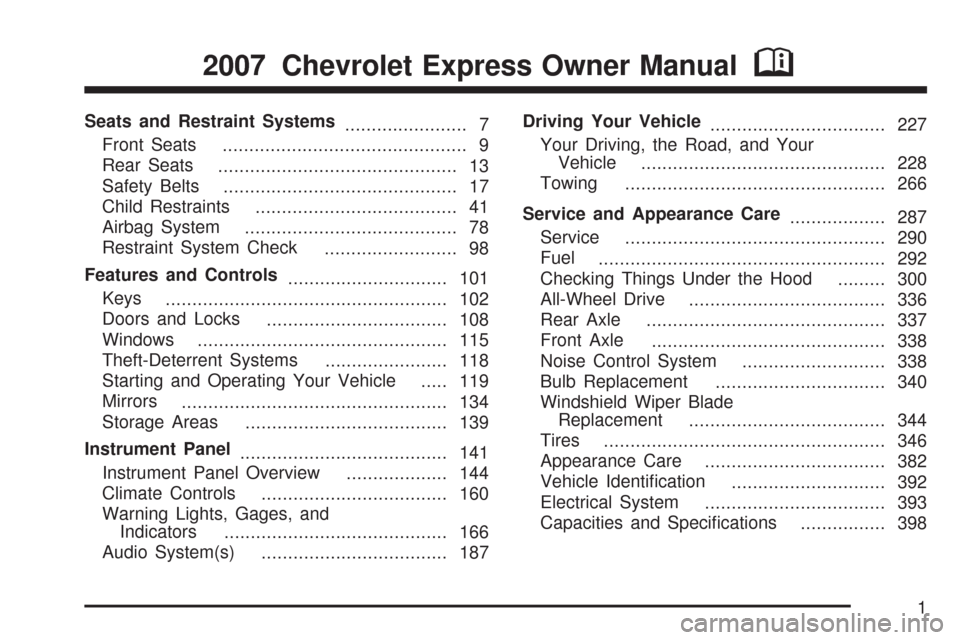
Seats and Restraint Systems
....................... 7
Front Seats
.............................................. 9
Rear Seats
............................................. 13
Safety Belts
............................................ 17
Child Restraints
...................................... 41
Airbag System
........................................ 78
Restraint System Check
......................... 98
Features and Controls
.............................. 101
Keys
..................................................... 102
Doors and Locks
.................................. 108
Windows
............................................... 115
Theft-Deterrent Systems
....................... 118
Starting and Operating Your Vehicle
..... 119
Mirrors
.................................................. 134
Storage Areas
...................................... 139
Instrument Panel
....................................... 141
Instrument Panel Overview
................... 144
Climate Controls
................................... 160
Warning Lights, Gages, and
Indicators
.......................................... 166
Audio System(s)
................................... 187Driving Your Vehicle
................................. 227
Your Driving, the Road, and Your
Vehicle
.............................................. 228
Towing
................................................. 266
Service and Appearance Care
.................. 287
Service
................................................. 290
Fuel
...................................................... 292
Checking Things Under the Hood
......... 300
All-Wheel Drive
..................................... 336
Rear Axle
............................................. 337
Front Axle
............................................ 338
Noise Control System
........................... 338
Bulb Replacement
................................ 340
Windshield Wiper Blade
Replacement
..................................... 344
Tires
..................................................... 346
Appearance Care
.................................. 382
Vehicle Identification
............................. 392
Electrical System
.................................. 393
Capacities and Specifications
................ 398
2007 Chevrolet Express Owner ManualM
1
Page 95 of 458
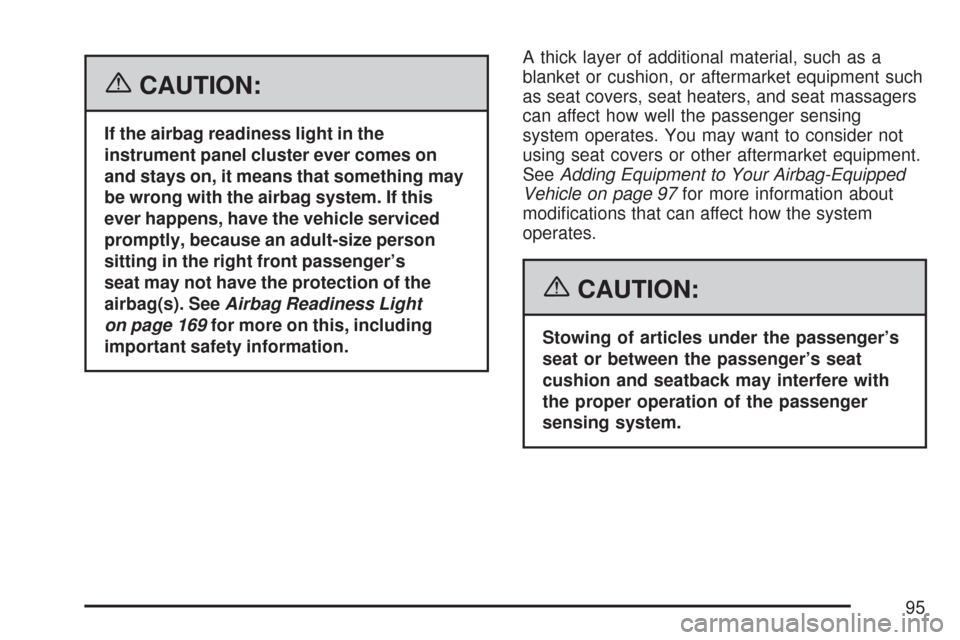
{CAUTION:
If the airbag readiness light in the
instrument panel cluster ever comes on
and stays on, it means that something may
be wrong with the airbag system. If this
ever happens, have the vehicle serviced
promptly, because an adult-size person
sitting in the right front passenger’s
seat may not have the protection of the
airbag(s). SeeAirbag Readiness Light
on page 169for more on this, including
important safety information.A thick layer of additional material, such as a
blanket or cushion, or aftermarket equipment such
as seat covers, seat heaters, and seat massagers
can affect how well the passenger sensing
system operates. You may want to consider not
using seat covers or other aftermarket equipment.
SeeAdding Equipment to Your Airbag-Equipped
Vehicle on page 97for more information about
modifications that can affect how the system
operates.
{CAUTION:
Stowing of articles under the passenger’s
seat or between the passenger’s seat
cushion and seatback may interfere with
the proper operation of the passenger
sensing system.
95
Page 119 of 458
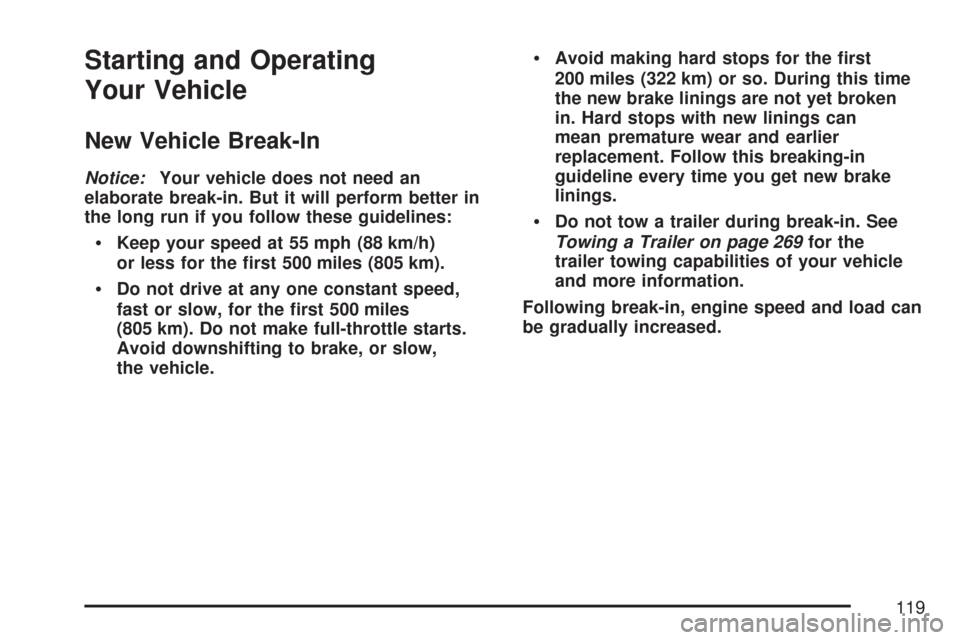
Starting and Operating
Your Vehicle
New Vehicle Break-In
Notice:Your vehicle does not need an
elaborate break-in. But it will perform better in
the long run if you follow these guidelines:
Keep your speed at 55 mph (88 km/h)
or less for the �rst 500 miles (805 km).
Do not drive at any one constant speed,
fast or slow, for the �rst 500 miles
(805 km). Do not make full-throttle starts.
Avoid downshifting to brake, or slow,
the vehicle.
Avoid making hard stops for the �rst
200 miles (322 km) or so. During this time
the new brake linings are not yet broken
in. Hard stops with new linings can
mean premature wear and earlier
replacement. Follow this breaking-in
guideline every time you get new brake
linings.
Do not tow a trailer during break-in. See
Towing a Trailer on page 269for the
trailer towing capabilities of your vehicle
and more information.
Following break-in, engine speed and load can
be gradually increased.
119
Page 125 of 458
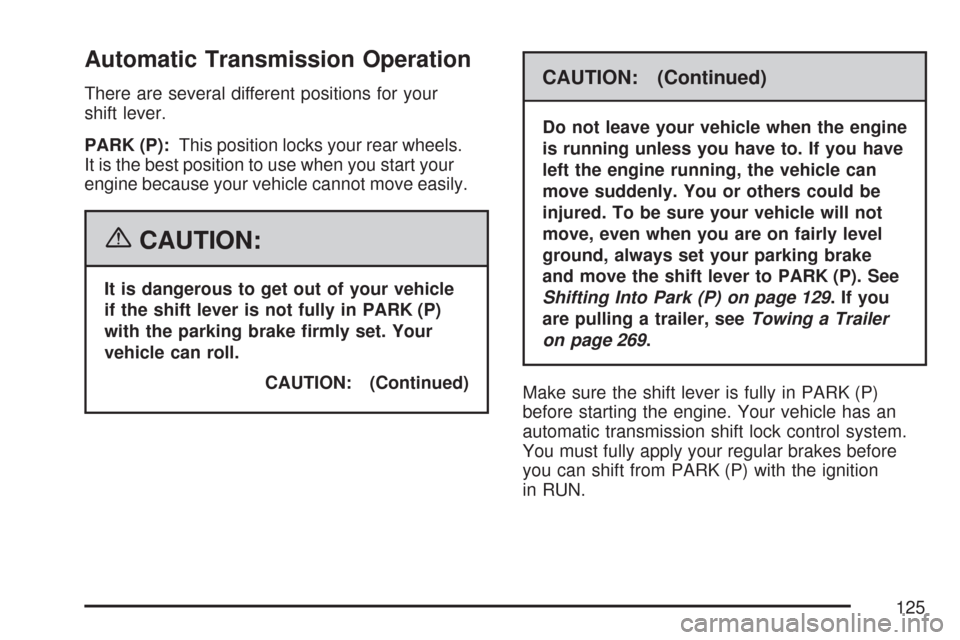
Automatic Transmission Operation
There are several different positions for your
shift lever.
PARK (P):This position locks your rear wheels.
It is the best position to use when you start your
engine because your vehicle cannot move easily.
{CAUTION:
It is dangerous to get out of your vehicle
if the shift lever is not fully in PARK (P)
with the parking brake �rmly set. Your
vehicle can roll.
CAUTION: (Continued)
CAUTION: (Continued)
Do not leave your vehicle when the engine
is running unless you have to. If you have
left the engine running, the vehicle can
move suddenly. You or others could be
injured. To be sure your vehicle will not
move, even when you are on fairly level
ground, always set your parking brake
and move the shift lever to PARK (P). See
Shifting Into Park (P) on page 129.Ifyou
are pulling a trailer, seeTowing a Trailer
on page 269.
Make sure the shift lever is fully in PARK (P)
before starting the engine. Your vehicle has an
automatic transmission shift lock control system.
You must fully apply your regular brakes before
you can shift from PARK (P) with the ignition
in RUN.
125
Page 127 of 458
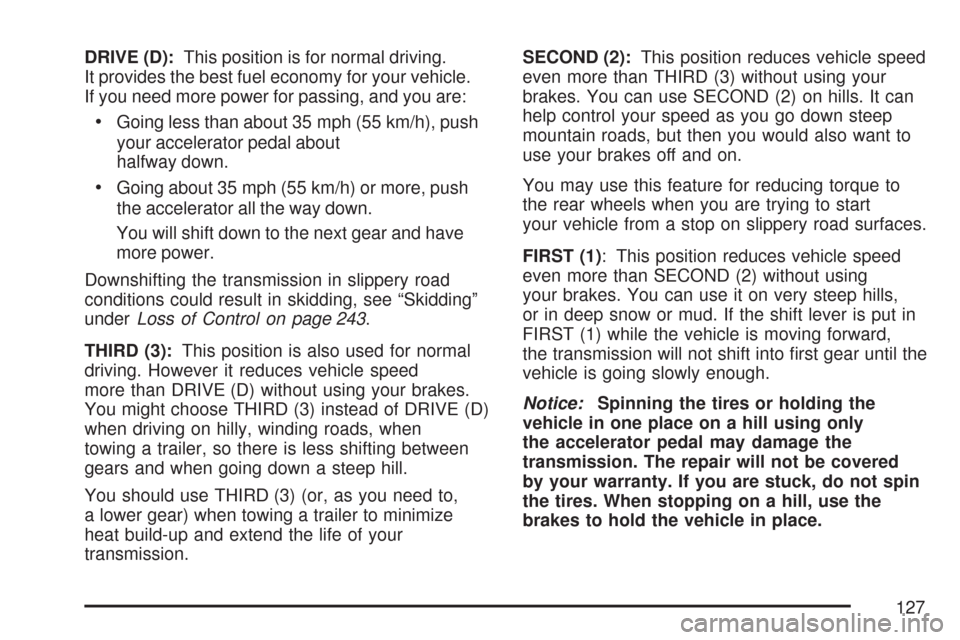
DRIVE (D):This position is for normal driving.
It provides the best fuel economy for your vehicle.
If you need more power for passing, and you are:
•Going less than about 35 mph (55 km/h), push
your accelerator pedal about
halfway down.
•Going about 35 mph (55 km/h) or more, push
the accelerator all the way down.
You will shift down to the next gear and have
more power.
Downshifting the transmission in slippery road
conditions could result in skidding, see “Skidding”
underLoss of Control on page 243.
THIRD (3):This position is also used for normal
driving. However it reduces vehicle speed
more than DRIVE (D) without using your brakes.
You might choose THIRD (3) instead of DRIVE (D)
when driving on hilly, winding roads, when
towing a trailer, so there is less shifting between
gears and when going down a steep hill.
You should use THIRD (3) (or, as you need to,
a lower gear) when towing a trailer to minimize
heat build-up and extend the life of your
transmission.SECOND (2):This position reduces vehicle speed
even more than THIRD (3) without using your
brakes. You can use SECOND (2) on hills. It can
help control your speed as you go down steep
mountain roads, but then you would also want to
use your brakes off and on.
You may use this feature for reducing torque to
the rear wheels when you are trying to start
your vehicle from a stop on slippery road surfaces.
FIRST (1): This position reduces vehicle speed
even more than SECOND (2) without using
your brakes. You can use it on very steep hills,
or in deep snow or mud. If the shift lever is put in
FIRST (1) while the vehicle is moving forward,
the transmission will not shift into first gear until the
vehicle is going slowly enough.
Notice:Spinning the tires or holding the
vehicle in one place on a hill using only
the accelerator pedal may damage the
transmission. The repair will not be covered
by your warranty. If you are stuck, do not spin
the tires. When stopping on a hill, use the
brakes to hold the vehicle in place.
127
Page 128 of 458
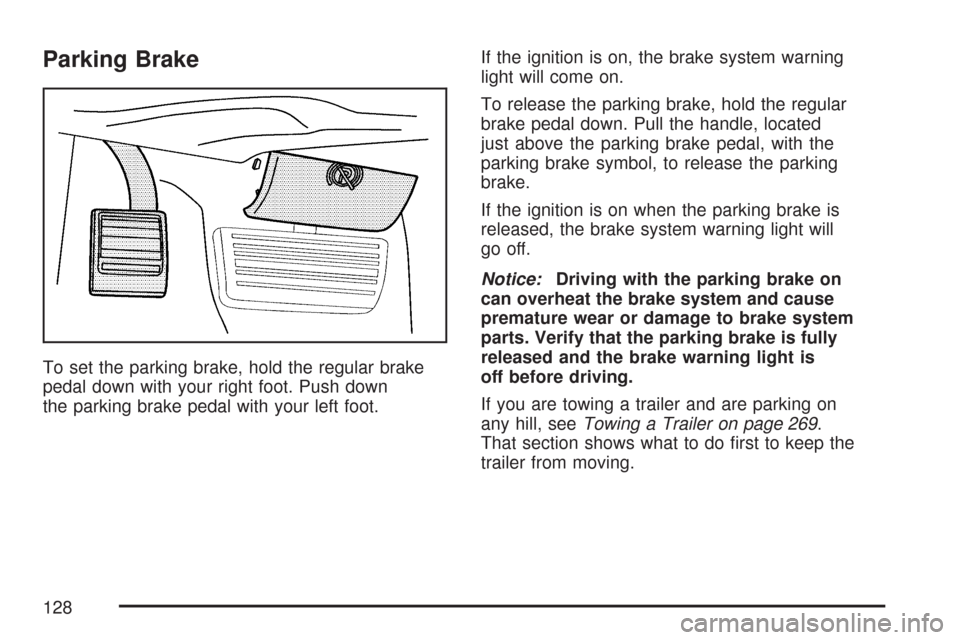
Parking Brake
To set the parking brake, hold the regular brake
pedal down with your right foot. Push down
the parking brake pedal with your left foot.If the ignition is on, the brake system warning
light will come on.
To release the parking brake, hold the regular
brake pedal down. Pull the handle, located
just above the parking brake pedal, with the
parking brake symbol, to release the parking
brake.
If the ignition is on when the parking brake is
released, the brake system warning light will
go off.
Notice:Driving with the parking brake on
can overheat the brake system and cause
premature wear or damage to brake system
parts. Verify that the parking brake is fully
released and the brake warning light is
off before driving.
If you are towing a trailer and are parking on
any hill, seeTowing a Trailer on page 269.
That section shows what to do first to keep the
trailer from moving.
128
Page 129 of 458
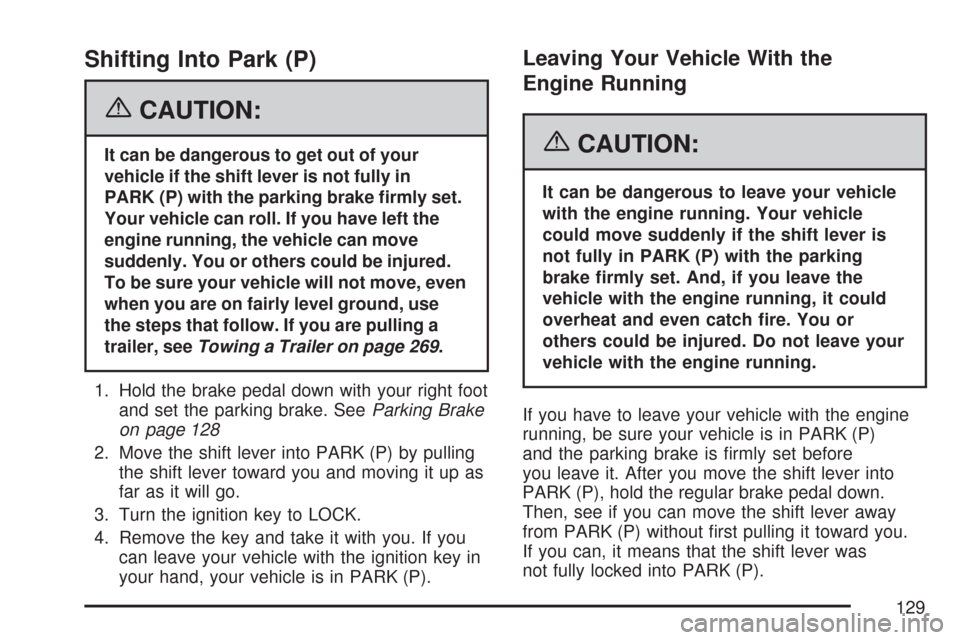
Shifting Into Park (P)
{CAUTION:
It can be dangerous to get out of your
vehicle if the shift lever is not fully in
PARK (P) with the parking brake �rmly set.
Your vehicle can roll. If you have left the
engine running, the vehicle can move
suddenly. You or others could be injured.
To be sure your vehicle will not move, even
when you are on fairly level ground, use
the steps that follow. If you are pulling a
trailer, seeTowing a Trailer on page 269.
1. Hold the brake pedal down with your right foot
and set the parking brake. SeeParking Brake
on page 128
2. Move the shift lever into PARK (P) by pulling
the shift lever toward you and moving it up as
far as it will go.
3. Turn the ignition key to LOCK.
4. Remove the key and take it with you. If you
can leave your vehicle with the ignition key in
your hand, your vehicle is in PARK (P).
Leaving Your Vehicle With the
Engine Running
{CAUTION:
It can be dangerous to leave your vehicle
with the engine running. Your vehicle
could move suddenly if the shift lever is
not fully in PARK (P) with the parking
brake �rmly set. And, if you leave the
vehicle with the engine running, it could
overheat and even catch �re. You or
others could be injured. Do not leave your
vehicle with the engine running.
If you have to leave your vehicle with the engine
running, be sure your vehicle is in PARK (P)
and the parking brake is firmly set before
you leave it. After you move the shift lever into
PARK (P), hold the regular brake pedal down.
Then, see if you can move the shift lever away
from PARK (P) without first pulling it toward you.
If you can, it means that the shift lever was
not fully locked into PARK (P).
129
Page 133 of 458
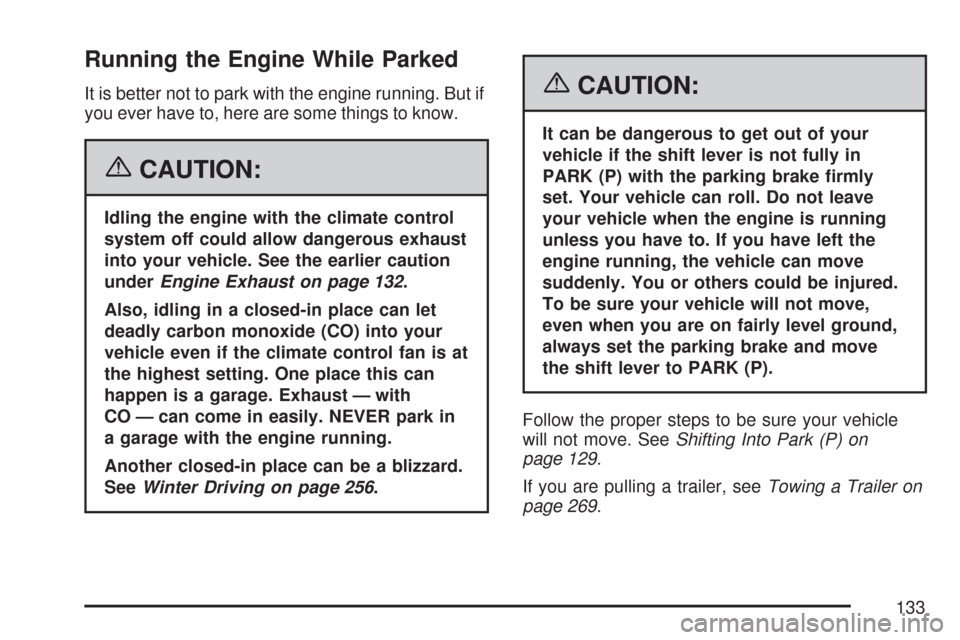
Running the Engine While Parked
It is better not to park with the engine running. But if
you ever have to, here are some things to know.
{CAUTION:
Idling the engine with the climate control
system off could allow dangerous exhaust
into your vehicle. See the earlier caution
underEngine Exhaust on page 132.
Also, idling in a closed-in place can let
deadly carbon monoxide (CO) into your
vehicle even if the climate control fan is at
the highest setting. One place this can
happen is a garage. Exhaust — with
CO — can come in easily. NEVER park in
a garage with the engine running.
Another closed-in place can be a blizzard.
SeeWinter Driving on page 256.
{CAUTION:
It can be dangerous to get out of your
vehicle if the shift lever is not fully in
PARK (P) with the parking brake �rmly
set. Your vehicle can roll. Do not leave
your vehicle when the engine is running
unless you have to. If you have left the
engine running, the vehicle can move
suddenly. You or others could be injured.
To be sure your vehicle will not move,
even when you are on fairly level ground,
always set the parking brake and move
the shift lever to PARK (P).
Follow the proper steps to be sure your vehicle
will not move. SeeShifting Into Park (P) on
page 129.
If you are pulling a trailer, seeTowing a Trailer on
page 269.
133